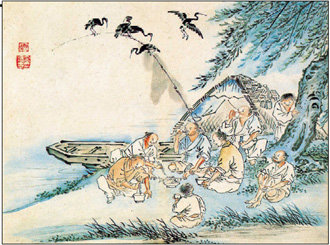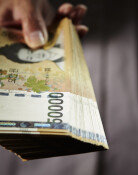History in a Spoonful of Rice
History in a Spoonful of Rice
Posted January. 28, 2005 22:56,

Food in Pictures, History in Food
Written by Joo Young-ha
280 pages / 15,000 won / SaKyeJul Publishing Inc.
When you think of Korea, you think of kimchi as its representative food. The author of Food in Pictures, History in Food, who is a folklorist and professor at the Academy of Korean Studies, never doubted the fact. He wrote papers and books emphasizing the superiority of kimchi, and immersed himself in research to prove the long history of kimchi in Korea.
Hes different now. The change came when he began writing a series of magazine articles on depictions of food in folk paintings from the Joseon dynasty. Compiling three years worth of articles into a single volume, the author realized that none of the paintings featured kimchi. In folk paintings by such famous painters as Kim Hong-do, Shin Yun-bok, and Kim Deuk-shin, as well as those by anonymous painters, you see rice, rice cakes, candy, grain wine, milk, tofu, yellow corvinas, mullets, bulgogi, and noodlesbut no kimchi.
According to the author Joo Young-ha, kimchi began to be hailed as Koreas representative food in the 1920s, with the full-scale onset of modernity. Here, he offers a hypothesis that combines Edward Saids Orientalism and Eric Hobbsbawms The Invention of Tradition.
We may have come to regard kimchi as Koreas defining food by internalizing the Western worlds Orientalist view of our culture. Our current view of kimchi may also have been a new tradition invented out of a dire sense of necessity for cementing our national identity amid the sweeping current of modernity.
Then what really is our representative food? Joo focuses on rice. Our meals were so rice-centric that 19th-century missionaries cited the Joseon people as the biggest rice eaters in Asia. One record even attests, Mothers seat their children on their laps and vigorously feed them rice and other foods, sometimes even tapping the childrens stomachs with the spoon handle to see if they are full.
In Kim Deuk-shins painting Gang Sang Hoi Eum (江上會飮, Revelry on the River), fishermen gather over a meal of rice and a single steamed mullet. Kimchi, like the equally salty and spicy steamed mullet, was developed to enable the consumption of mass quantities of rice. In short, kimchi was subordinate to rice from the first, but today kimchi has taken center stage while rice is consigned to the wings.
In the Joseon dynasty, rice wasnt just food. It symbolized our ancestors, and even human life itself. In Shin Yun-boks Mu Nyeo Shin Moo (巫女神舞, Dance of a Female Shaman), rice composes one of the offerings in the ritual service. Injeolmi and other cakes, which frequently appear alongside drinks and in festive meals, are also made of sticky rice. In memorial rites for ancestors, rice occupied the highest place; in shamanic rituals, rice cakes took its place.
What about wine? Describing the drinks an old female wine-seller peddles by the roadside in Kim Hong-dos Haeng Ryeo Pung Sok Do Byeong (行旅風俗圖屛, Screen Depicting the Wandering Life), Joo introduces the cripples wine, which is so delicious that even a person with urgent business finds himself unable to get up and leave the table. Cripples wine is the nickname for a kind of wine made on the seasonal holiday of Cheongmyeong (around April 5 on the solar calendar). Famous varieties of this wine include Gamhongro-ju from Pyongyang, Soguk-ju from Hansan, Baek-ju from Hongcheon, and Hosanchun-ju from Yeosan (todays Iksan). And they all use regular or sticky rice as the main ingredient.
The white candy enjoyed as a special treat on the May holiday of Dano was also made by liquefying sticky or non-sticky rice, hardening it into candy, then re-heating it for shaping.
The book demonstrates that what we believed to be traditional Korea fare is the result of modernization. Asian sweet potatoes, known to have been imported in the 18th century for famine relief, only began to be cultivated around the country after modernistic improvements had been made to the crop. Noodles were made principally of buckwheat throughout the Joseon period, and wheat flour was popularized only toward the end of the 1930s, when Japan began to promote eating a mixture of foods in order to concentrate on the war.
Joo Young-has book, a study on the history of food by way of 23 folk paintings, accords with the latest historiographical method known as Picturing History, which seeks to read history through images. But, as Joo himself points out, even folk paintings do not transparently reflect contemporaneous reality; they are selective representations of only those phenomena that best correspond with the spirit of the times. In other words, there may be another reality that is absent from folk paintings.
The appeal of this book probably lies in its provocative critical approach: the idea that what we regard as tradition may in fact be the invention of modern times.
Chae-Hyun Kwon confetti@donga.com



![[단독]‘아들 주택 11채’ 김경, 공천 보류됐다 강선우가 밀어붙여 구제](https://dimg.donga.com/c/138/175/90/1/wps/NEWS/IMAGE/2026/01/07/133103173.6.jpg)



